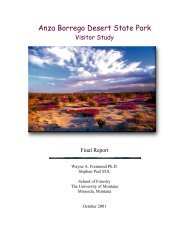Final Mitigated Negative Declaration and Response to Comments
Final Mitigated Negative Declaration and Response to Comments
Final Mitigated Negative Declaration and Response to Comments
You also want an ePaper? Increase the reach of your titles
YUMPU automatically turns print PDFs into web optimized ePapers that Google loves.
CHAPTER 2<br />
PROJECT DESCRIPTION<br />
2.1 INTRODUCTION<br />
This Initial Study/<strong>Mitigated</strong> <strong>Negative</strong> <strong>Declaration</strong> (IS/MND) has been prepared by the<br />
California Department of Parks <strong>and</strong> Recreation (DPR) <strong>to</strong> evaluate the potential<br />
environmental effects of the proposed Asian Clam Control Project at Emerald Bay State<br />
Park, located in El Dorado County, California. The proposed project would control a<br />
population of invasive Asian clams near the mouth of Emerald Bay (see map: Appendix<br />
A).<br />
2.2 PROJECT LOCATION<br />
Lake Tahoe is a large, high elevation (approximately 6,223 ft.) lake in the Sierra Nevada<br />
Mountains. The lake sits in a basin encompassed by the Crystal Range <strong>to</strong> the west <strong>and</strong><br />
the Carson Range <strong>to</strong> the east. The border between California <strong>and</strong> Nevada divides the<br />
lake. Lake Tahoe Basin is approximately 20 miles southwest of Reno, Nevada <strong>and</strong><br />
approximately 80 miles northeast of Sacramen<strong>to</strong>, California.<br />
Emerald Bay State Park (SP) is located around Emerald Bay, a National Natural<br />
L<strong>and</strong>mark since 1968. It is immediately south <strong>and</strong> contiguous with D. L. Bliss SP. The<br />
park contains the only isl<strong>and</strong> in Lake Tahoe- Fannette Isl<strong>and</strong>. In 1994, DPR included<br />
the surrounding water of the bay as a part of the park, making Emerald Bay SP one of<br />
the first underwater parks of its type in the state. The underwater park is managed by<br />
DPR under a lease from the California State L<strong>and</strong>s Commission. The park is<br />
accessible by State Route 89 near the southwest shore of the lake. The unit is 663 l<strong>and</strong><br />
acres in size, with the underwater area of Emerald Bay covering an additional 870<br />
acres. There is approximately 14,130 feet of shoreline along Lake Tahoe.<br />
2.3 BACKGROUND AND NEED FOR THE PROJECT<br />
Asian clam (Corbicula fluminea; AC) were first documented in Lake Tahoe in 2002 (U.C.<br />
Davis 2009; Whittmann et al. 2011). Since the initial AC detection, the populations in<br />
South Lake Tahoe increased rapidly from 1 <strong>to</strong> nearly 200 acres in less than 10 years<br />
with densities up <strong>to</strong> 6,000 individuals per square meter measured (U.C. Davis 2010). A<br />
relatively sparse population was discovered near the mouth of Emerald Bay in 2009.<br />
Initial surveys estimated this infestation at approximately 3.5 acres in size just inside<br />
<strong>and</strong> on the south side of the mouth of Emerald Bay, in water depths of 6 <strong>to</strong> 30 feet (see<br />
map: Appendix A). Surveys in 2011 showed the infestation had spread <strong>to</strong><br />
approximately 5.5 acres (2011 U.C. Davis Survey Results; see Appendix A), an<br />
increase in infestation size of over 40% in only two years. An expansion of the Emerald<br />
Bay infestation similar <strong>to</strong> that seen in South Lake Tahoe would result in considerable<br />
ecological <strong>and</strong> recreation impacts.<br />
Asian Clam Control Project IS/MND<br />
Emerald Bay State Park<br />
California Department of Parks <strong>and</strong> Recreation<br />
8
















